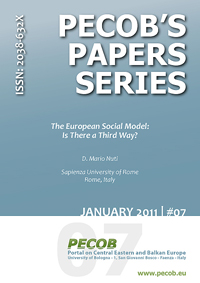and Balkan Europe
by IECOB & AIS Università di Bologna

This area collects and offers a wide range of scientific contributions and provides scholars, researchers and specialists with publishing opportunities for their research results
The European Social Model: Is There a Third Way?
January 2011| #07
by: D. Mario Nuti
pp: 20
ISSN: 2038-632X

- January 2011 | #07
Abstract
The search for a Third Way, intermediate between socialism and capitalism, began even before the birth of the Soviet Union, whose observed drawbacks encouraged a further search. There have been at least three alternative projects within this approach: Market Socialism, combining public ownership, market allocation and socialist values of high employment, growth and equality. This was the target of many failed attempts at reforming the Soviet-type model, in the 1960s to the 1980s. Its best, though partial, embodiment is the Chinese economy circa 1980-2000.
The New Labour paradigm of the late 1990s, accepting the dominant role of private ownership and enterprise, the primacy of domestic and global markets and budgetary discipline. The model was a move in the right direction but it went too far in some respects, and not far enough in others. It was rejected by electors and its resurrection today would require a major overhaul.
The European Social Model (ESM), emphasising the role of institutions as well as markets in resource allocation, with employment protection and a generous welfare state.
This model performed rather well in the 2000s but:
1. its institutions and policies were never part of the acquis communautaire and its implementation was left to the discretion of member states; therefore it was significantly diluted by the European Enlargement to the Central Eastern European countries, that – with the exception of Slovenia and to some extent Estonia – adopted the hyper-liberal model fashionable at the time of their transition to capitalism in 1989-1991;
2. the increasing globalisation of labour, due not only to the more spectacular phenomena of de-localisation (caused by capital mobility) and labour migrations, but above all due to trade growth, has threatened employment, real wages and tax revenues in the more advanced countries such as those that had adopted the ESM;
3. even in those countries that did implement it fully, in spite of the stringencies of the Growth and Stability Pact, eventually the European Social Model was wrecked by the cuts in government expenditure adopted as a response to the global economic crisis of 2008-2010 and to generalised concerns about the sustainability of government debt.
In this paper I will review these three alternative Third Ways, concentrating on the ESM. My conclusion is that the European Social Model is still a viable and sustainable alternative, but only after the consolidation of public finances, subject to the constraints of global competition, and as an alternative to competing uses of public resources.
Keywords
economic systems, welfare, Europe, enlargement, crisis, ESM
Table of contents
Abstract
Keywords
1 Market Socialism
2 The New Labour paradigm of the late 1990s
3 The European Social Model
3.1 ESM and US models compared
3.2 ESM dilution: rising costs and EU enlargement
3.3 ESM dilution: Globalisation and the recent crisis
4 Conclusions
References


 Download the full paper!
Download the full paper!





